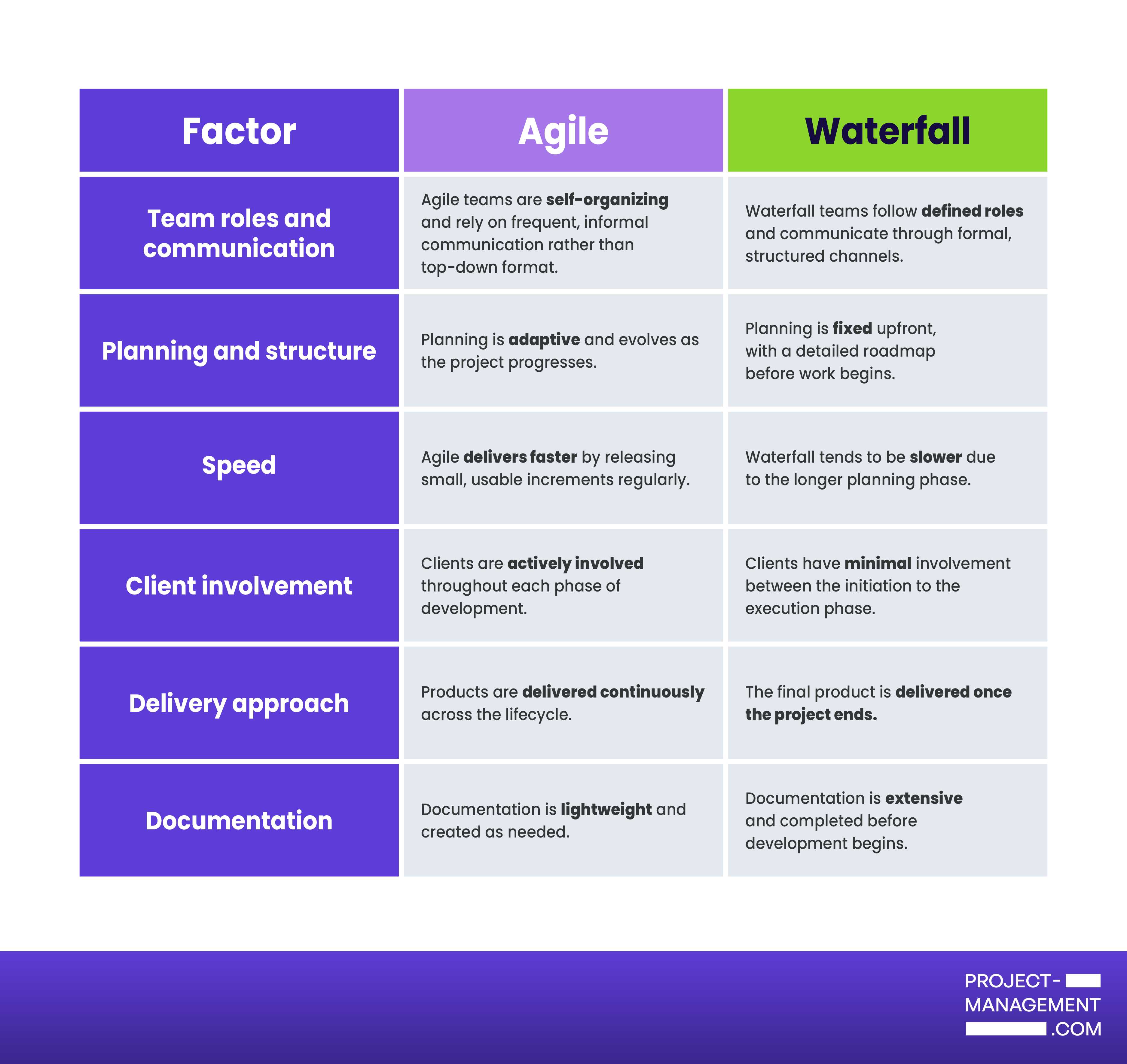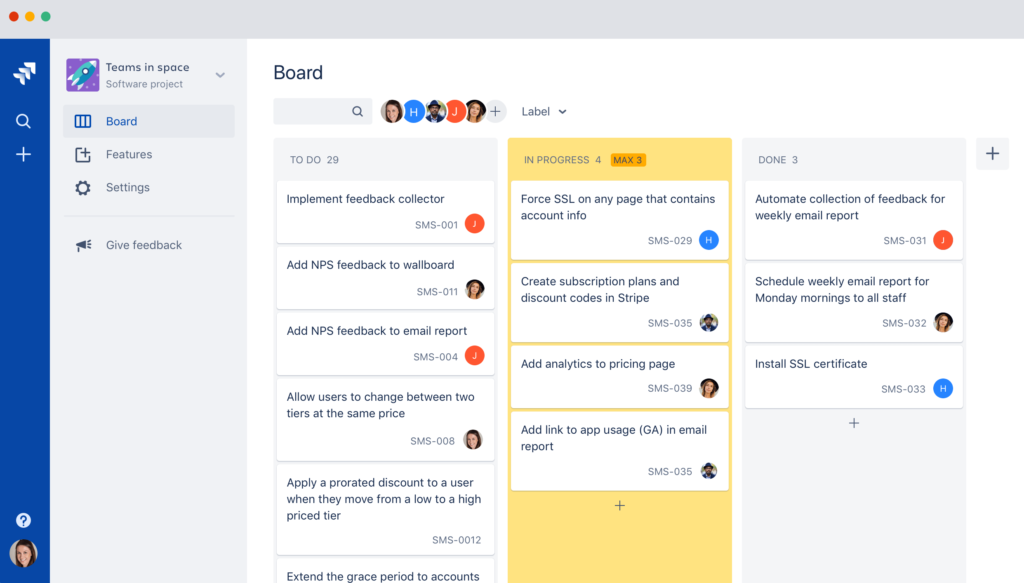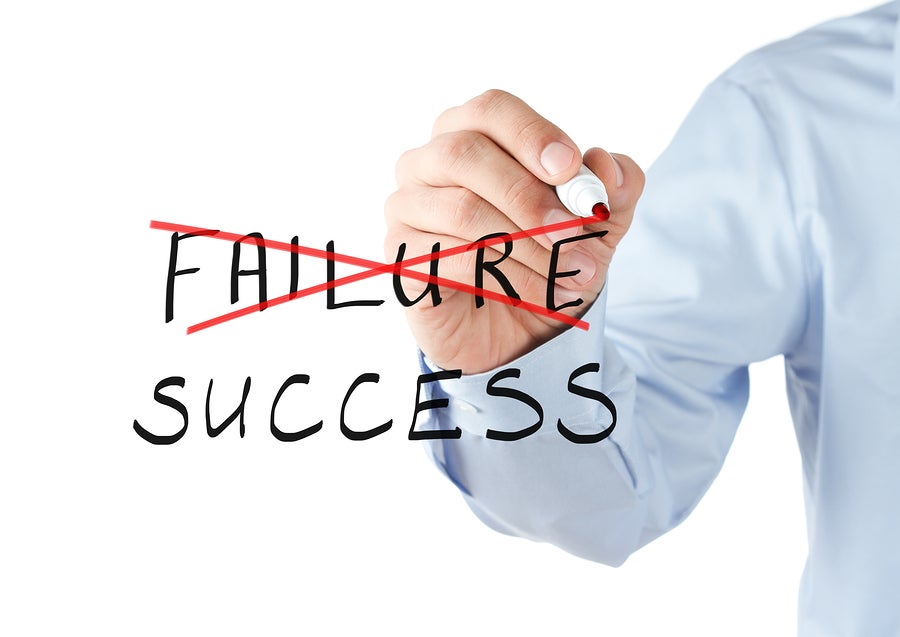KEY TAKEAWAYS
Agile project management has grown into one of the top project management methodologies in recent years as teams strive to tackle project management challenges in a more flexible and dynamic manner. Read on to learn more about what agile project management is, its benefits, key principles, and real-world examples.
What is agile project management?
Agile project management is a methodology that focuses on breaking the larger project life cycle into more approachable portions of time and smaller tasks. Rather than delivering project deliverables and products at the conclusion of a project, agile project management prioritizes the delivery of a working product throughout the process, allowing the project team and all types of stakeholders to work together during the project execution while providing feedback — not just during the project post-mortem.
Unlike traditional project management methods, agile allows teams to pivot in new directions as needed and adapt to changing circumstances or project needs.
Key principles of agile project management
The Agile Manifesto outlines values and principles that are used to guide the execution of agile projects.
- Our highest priority is to satisfy the customer through the early and continuous delivery of valuable software.
- Welcome changing requirements, even late in development. Agile processes harness change for the client’s competitive advantage.
- Deliver working software (or products) frequently, from a couple of weeks to a few months, with a preference for the shorter timescale.
- Business people and developers must work together daily throughout the project.
- Build projects around motivated individuals. Give them the environment and support they need, and trust them to get the job done.
- Face-to-face conversation is the most efficient and effective method of conveying information within a development team.
- Working software (and products) are the primary measure of progress.
- Agile processes promote sustainable development. The sponsors, developers, and users should be able to maintain a constant pace indefinitely.
- Continuous attention to technical excellence and good design enhances agility.
- Simplicity—the art of maximizing the amount of work not done—is essential.
- The best architectures, requirements, and designs emerge from self-organizing teams.
- At regular intervals, the team reflects on how to become more effective, then tunes and adjusts its behavior accordingly.
Read more: Agile software development methodology & principles
Tips for implementing agile project management
Transitioning your team to agile doesn’t have to be overwhelming. Whether you’re exploring agile project management books or starting hands-on, these tips will help you implement the agile project management process with confidence.
Educate your team
Before diving in, ensure your team fully understands agile principles. One of the main responsibilities of the Scrum Master, in particular, is to hold training sessions that clarify key terminology and demonstrate practical workflows. By making sure your team understands the principles of agile project management, you are equipping them with the proper knowledge and tools to implement the methodology properly.
Consider your project’s needs when choosing the agile framework for your project
The following list includes all the different agile frameworks from which you can choose. When deciding on which one to adopt for your project, revisit your objectives and choose the one that is best suited for your project’s needs:
- Scrum: Best for teams thriving on structure with clear roles, sprints, and ceremonies
- Kanban: Best for continuous delivery environments, offering a visual workflow that highlights bottlenecks
- Lean software development: Best for waste reduction and continuous improvement
- Feature-driven development (FDD): Best for larger teams requiring detailed documentation and clear feature breakdowns
- Adaptive software development (ASD): Best for highly dynamic projects requiring rapid iterations and minimal planning overhead
- Extreme Programming (XP): Best for software testing
Set clear objectives during planning
When planning your iterations or sprints, clearly define what you want to achieve at the end. Assign tasks clearly to team members and make sure everyone knows their responsibilities. Your team must accomplish specific deliverables for clear accountability.
Conduct regular meetings
Hold short daily meetings (daily standups) to maintain transparency, quickly address challenges, and maintain momentum. These should be brief but effective, addressing what each team member accomplished, plans to tackle next, and any barriers they’re facing.
Review your work
Organize sprint review meetings to assess your team’s progress and gather feedback from team members, developers, and stakeholders. Identify areas where changes are needed and apply them before the next sprint begins. Incremental adjustments can refine your agile practices and maintain team alignment.
Use project management software
Employ project management software like Jira, Monday.com, or ClickUp to manage your projects better. These tools help organize tasks, visualize workflows, track progress, and support transparent collaboration among team members.
An expert’s recipe for agile success
“Agile is a very effective methodology of managing projects — when implemented correctly. In my experience, the most critical part of success has been implementing a daily, in-person stand-up meeting.
I was at an organization where we started our daily stand-up meetings virtually, with everyone in the same room but at their desks on their phones. We later changed the meeting to be in-person, and the dynamic of the team changed. People were more open, there was more collaboration, and we accomplished more in a short time.
In addition to changing the daily stand-up to in-person, I also introduced a Kanban board. This allowed the developers to create a friendly competition to see who could move the most tasks daily and throughout the sprint.
I have also worked on non-software development projects that successfully leveraged agile because it focuses on the timeboxed approach rather than the task-driven approach. Additional ceremonies, such as the sprint retrospective, sprint planning, and sprint review meetings, were also critical to the success, as they focused the team’s energy on the tasks at hand and allowed for an honest look at the work.
Having been both a project manager and Scrum Master, I can say that they serve two different roles in two different methodologies. The agile methodology is more than just an idea; it is a mindset, and one of the roles of the Scrum Master is to educate and inspire this concept.”
Comparing agile to traditional project management
Agile and waterfall are two of the most well-recognized project management methodologies. They are often referenced as opposites, but their relationship is more complex than that.
When comparing agile and waterfall project management methodologies, six key factors typically stand out: team roles and communication style, planning and structure, speed, client involvement, delivery approach, and documentation style.

Here are some facts about agile and waterfall:
- The agile methodology was created as a response to some of the limitations that fast-moving project teams faced when navigating projects using more traditional methods like waterfall.
- Teams are not exclusively limited to the use of one methodology over another. While one project may require the rigid structure of waterfall, another may require the flexibility of agile.
- Moreover, hybrid approaches combining agile and waterfall are possible in project management. In select circumstances, project teams may successfully combine certain guidelines from waterfall and agile.
The six phases of agile development
Before implementing the agile approach, it’s important to familiarize yourself with its distinct project phases. Agile’s life cycle is iterative, meaning each phase repeats regularly, refining the project outcomes as the team progresses.
1. Concept and initiation: This initial stage defines your project vision. You identify project goals, stakeholders, and key requirements. Agile teams host meetings to establish clear priorities and create an initial backlog or a dynamic task list critical for project completion.
2. Planning and design: Unlike traditional methods, agile emphasizes flexibility during the planning stage. Teams break down larger tasks into manageable pieces or user stories, deciding what can realistically be completed within short, repeatable cycles called iterations or sprints.
3. Development (iterations): In each iteration, your team designs, builds, and tests a portion of the product. Frequent collaboration and stakeholder communication align the project with user expectations and business needs.
4. Testing and feedback: Testing isn’t left to the end of the project because agile integrates testing continuously throughout every iteration. Regular feedback from stakeholders ensures adjustments are quickly incorporated, preventing costly errors down the line.
5. Release and deployment: Agile teams deliver working components incrementally, allowing users and stakeholders to interact with real features early and often. This incremental approach reduces risk, provides value sooner, and allows adjustments based on actual user experience.
6. Review and retrospective: At the conclusion of each iteration, your team conducts reviews to assess completed work and retrospectives to evaluate team processes. You discuss what worked well and what didn’t and identify areas for improvement, ensuring each subsequent iteration becomes more efficient.
Popular agile frameworks
Choosing the right agile framework can make a big difference in how your team collaborates and delivers results. Below are some of the most widely used agile project management methods, each offering a unique approach to managing workflows, roles, and project timelines.
Kanban
The Kanban framework is based on the Japanese word kanban, which means visual card. It uses a card-like layout to represent each task within a project. Typically, Kanban boards are labeled To-Do, In Progress, and Completed to indicate the task’s stage of completion, though teams have complete freedom to decide how they want to label or organize their boards in a manner that aligns with their workflow.

As tasks hit milestones, they move under the category that reflects their current status, making it easy to visualize where individual tasks are in the larger project life cycle. An agile tool like ClickUp offers intuitive Kanban boards, allowing your team to visualize workflows effectively.
Scrum
Scrum breaks down projects into smaller “sprints” of time that are isolated from the rest of the project. Scrum teams are led by a Scrum Master who makes sure team members understand and apply agile practices properly and effectively. Once a project is divided into sprints, the Scrum Master guides the team through each one and facilitates agile Scrum ceremonies.
monday.com supports Scrum by providing built-in sprint planning capabilities, backlog management, and reporting features to streamline your team’s agile processes.

Lean software development
This is a great agile methodology for teams aiming to reduce waste and streamline product delivery. Rooted in manufacturing principles, it eliminates unnecessary tasks, processes, and resources.

Lean focuses on efficiency and continuous improvement through principles like empowering teams, making decisions late (to remain flexible), and rapidly delivering small increments of functionality. Tools like Kanban boards in Jira can help visualize your workflow, making it easier to spot waste and bottlenecks.
Feature-driven development (FDD)
This agile framework is ideal for projects involving detailed requirements and clearly defined products. FDD breaks down complex projects into small, manageable features that are designed, developed, and tested individually.
Teams follow a structured roadmap for accountability and consistent progress. Your team could use monday.com to track each feature’s progress through development stages, improving transparency and productivity.
Adaptive software development (ASD)
ASD is suitable for teams operating in dynamic, unpredictable environments that demand rapid adaptation. Rather than planning everything upfront, your team embraces iterative cycles of speculation, collaboration, and learning to quickly respond to feedback and changing market conditions. It empowers your project to adapt swiftly as new information emerges, helping ensure your end product continually aligns with user and stakeholder needs.
eXtreme Programming (XP)
XP is an agile framework geared toward teams that aim to overcome common issues in developing software. XP has 12 supporting processes that outline the framework:
- Planning game
- Small releases
- Customer acceptance tests
- Simple design
- Pair programming
- Test-driven development
- Refactoring
- Continuous integration
- Collective code ownership
- Coding standards
- Metaphor
- Sustainable pace
Agile project management tools such as Jira or ClickUp can support your team’s rigorous development processes, from tracking tasks and customer feedback to supporting continuous integration and refactoring efforts.
Pros and cons of agile
Pros
Cons
Agile project management case studies
Agile methodologies can significantly enhance not only operational efficiency but also customer engagement and overall project success. The case studies below demonstrate how adopting agile through Scrum and Kanban can solve immediate challenges and help businesses stay competitive long-term.
Case study # 1: Midsize software company
Initially using waterfall, the company struggled with delayed releases and customer dissatisfaction due to long development cycles and minimal feedback. After adopting Scrum, the company divided its projects into shorter sprints, allowing frequent customer reviews and incremental product releases.
Within six months, they saw dramatic improvements in productivity as shorter, manageable goals kept the team engaged and motivated. Customer satisfaction also increased due to frequent product updates and stakeholder involvement throughout the process. More importantly, bug fixes and rework decrease as they start implementing continuous testing and immediate feedback loops.
Case study # 2: Financial tech startup
A fintech startup manages its product releases using a structured, linear process that often results in missed deadlines, rigid workflows, and limited flexibility. Stakeholder requirements changed often, but their processes couldn’t accommodate these shifts quickly enough.
After shifting to Kanban methodology, the company noticed an increase in workflow visibility. They implemented Jira as their project management tool that offers a clear, visual board dividing task statuses into “To-Do,” “In Progress,” and “Done.” Teams can now quickly spot bottlenecks and redistribute workloads more effectively. The company conducted regular review sessions, allowing continuous stakeholder feedback and rapid course corrections.
History of agile project management
Agile project management came about as a response to the 1990s technology boom when developers of new technologies realized the limitations of methodologies, like waterfall, that were not designed to produce a tangible product quickly.
In response, a group of 17 developers met in Snowbird, Utah, to discuss ideas together as “organizational anarchists” seeking to find a better way. After three days of discussion, they settled on the foundational ideas of modern agile project management — resulting in the creation of the Agile Manifesto.
Agile has gone on to become one of the most frequent methodologies, and at present, several agile project management software tools are available to make this approach smoother for project teams.
READ MORE: What is project management?







